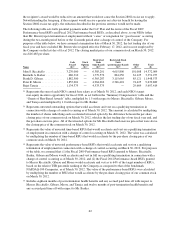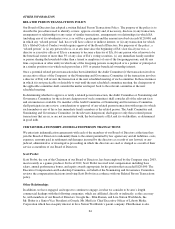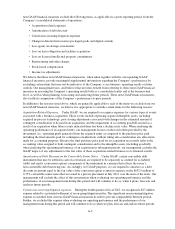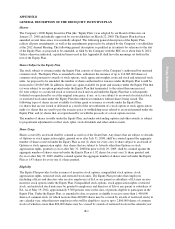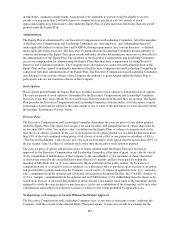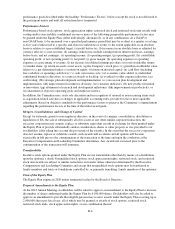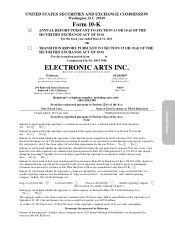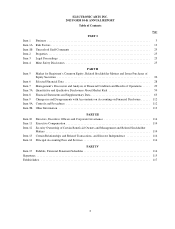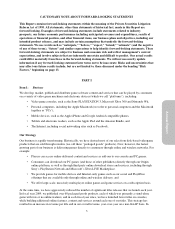Electronic Arts 2012 Annual Report Download - page 77
Download and view the complete annual report
Please find page 77 of the 2012 Electronic Arts annual report below. You can navigate through the pages in the report by either clicking on the pages listed below, or by using the keyword search tool below to find specific information within the annual report.
Proxy Statement
Change in Deferred Net Revenue (Packaged Goods and Digital Content). We are not able to objectively
determine the fair value of the online service included in certain of our packaged goods and digital content. As a
result, we recognize the revenue from the sale of these games and content over the estimated online service
period. In other transactions, at the date we sell the software product we have an obligation to provide
incremental unspecified digital content in the future without an additional fee. In these cases, we account for the
sale of the software product as a multiple element arrangement and recognize the revenue on a straight-line basis
over the estimated period of game play. Internally, our management excludes the impact of the change in
deferred net revenue related to packaged goods games and digital content in its non-GAAP financial measures
when evaluating our operating performance, when planning, forecasting and analyzing future periods, and when
assessing the performance of our management team. We believe that excluding the impact of the change in
deferred net revenue from our operating results is important to (1) facilitate comparisons to prior periods during
which we were able to objectively determine the fair value of the online service and not delay the recognition of
significant amounts of net revenue related to online-enabled packaged goods and (2) understanding our
operations because all related costs are expensed as incurred instead of deferred and recognized ratably.
Loss (Gain) on Strategic Investments. From time to time, we make strategic investments. Our management
excludes the impact of any losses and gains on such investments when evaluating the Company’s operating
performance, when planning, forecasting and analyzing future periods, and when assessing the performance of
our management team. In addition, we believe that excluding the impact of such losses and gains on these
investments from our operating results is important to facilitate comparisons to prior periods.
Loss on Lease Obligation and Facilities Acquisition. During the second quarter of fiscal 2010, we completed
the acquisition of our headquarters facilities in Redwood City, California pursuant to the terms of the loan
financing agreements underlying the build-to-suit leases for the facilities. These leases expired in July 2009, and
had previously been accounted for as operating leases. The total amount paid under the terms of the leases was
$247 million, of which $233 million related to the purchase price of the facilities and $14 million was for the loss
on our lease obligation. In addition, we recorded a tax benefit of approximately $31 million, consisting of
approximately $6 million related to the loss on our lease obligation, and a $25 million reduction in our valuation
allowance due to the acquisition. As a result of this lease obligation and facility acquisition, on an after-tax basis,
we incurred a positive net income effect of $17 million. Our management excluded the effect of this transaction
when evaluating the Company’s operating performance and when assessing the performance of our management
team during this period and will continue to do so, when it plans, forecasts and analyzes future periods.
Loss on Licensed Intellectual Property Commitment. During the fourth quarter of fiscal 2009, we amended an
agreement with a content licensor. This amendment resulted in the termination of our rights to use the licensor’s
intellectual property in certain products and we incurred a related estimated loss of $38 million. This significant
non-recurring loss is excluded from our non-GAAP financial measures in order to provide comparability between
periods. Further, we excluded this loss when evaluating our operating performance and the performance of our
management team during this period.
Restructuring and Other Charges. Although we have engaged in various restructuring activities in the past,
each has been a discrete, extraordinary event based on a unique set of business objectives. Each of these
restructurings has been unlike its predecessors in terms of its operational implementation, business impact and
scope. As such, we believe it is appropriate to exclude restructuring charges from our non-GAAP financial
measures.
Stock-Based Compensation. When evaluating the performance of our individual business units, we do not
consider stock-based compensation charges. Likewise, our management teams exclude stock-based
compensation expense from their short and long-term operating plans. In contrast, our management teams are
held accountable for cash-based compensation and such amounts are included in their operating plans. Further,
when considering the impact of equity award grants, we place a greater emphasis on overall shareholder dilution
rather than the accounting charges associated with such grants.
Income Tax Adjustments. We use a fixed, long-term projected tax rate of 28 percent internally to evaluate our
operating performance, to forecast, plan and analyze future periods, and to assess the performance of our
management team. Accordingly, we have applied the same 28 percent tax rate to our non-GAAP financial results.
A-3





